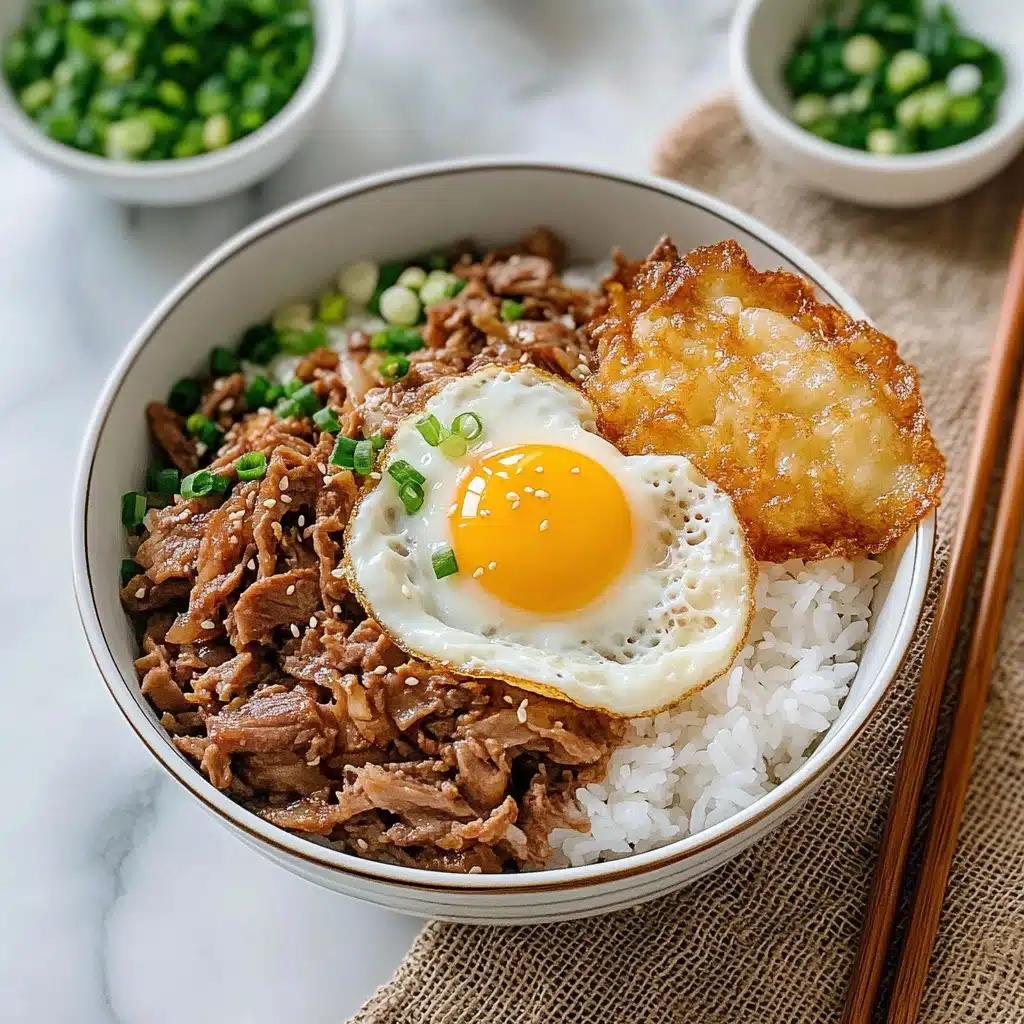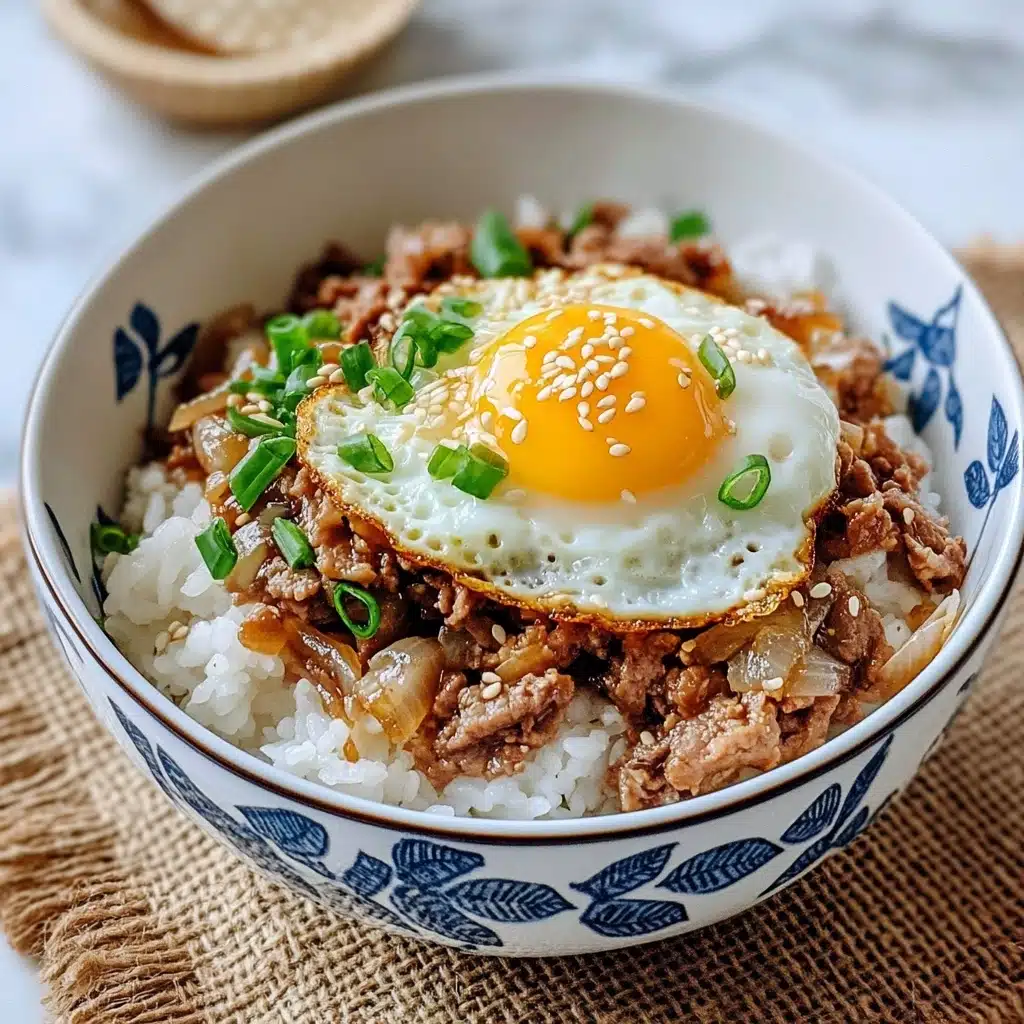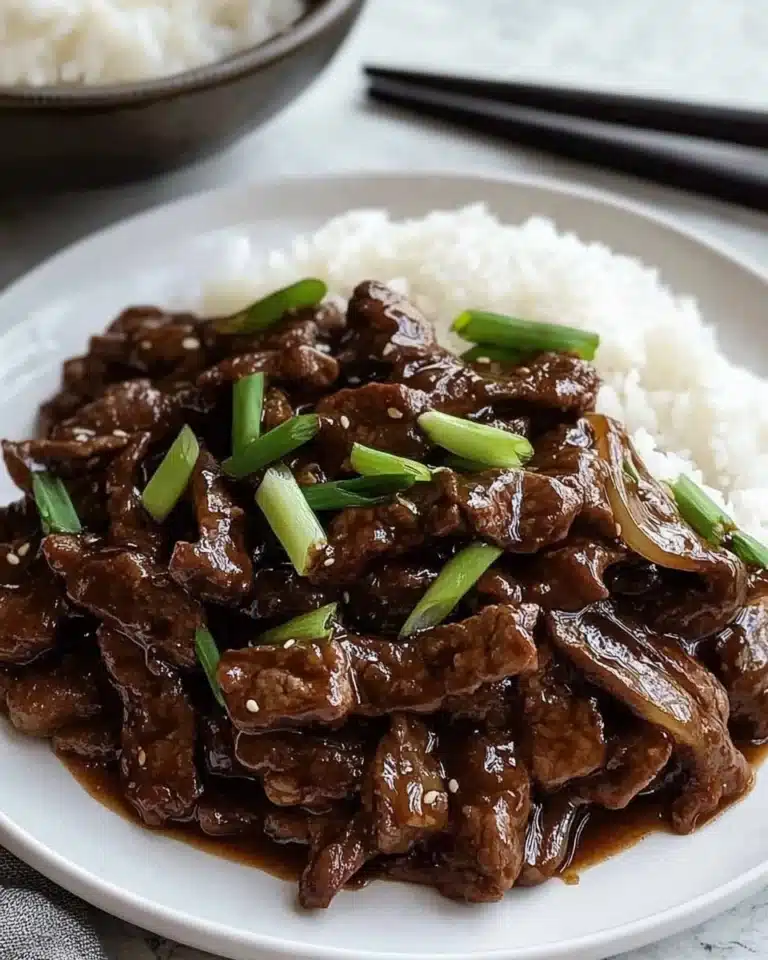I absolutely love this Japanese Beef & Rice Bowls (Gyudon) Recipe because it combines simplicity and incredible flavor in a way that’s approachable for any home cook. When I first tried making gyudon, I was surprised by how quickly I could create such a comforting, restaurant-quality dish with just a few everyday ingredients. It’s perfect for busy weeknights or when you want something filling and satisfying without a ton of fuss.
You’ll find that this classic Japanese comfort food hits all the right notes: tender, thinly sliced beef simmered in a subtly sweet and savory sauce, served over fluffy steamed rice, and topped with a runny egg that just brings everything together. Once you make this Japanese Beef & Rice Bowls (Gyudon) Recipe a few times, it becomes one of those meals you crave again and again, and trust me, your family or friends will go crazy for it too.
Why You’ll Love This Recipe
- Fast and Easy: This recipe comes together quickly, making it ideal for weeknight dinners when you want something tasty without a long cook time.
- Comfort Food Classic: Gyudon is a well-loved Japanese dish that’s hearty and satisfying, perfect for cravings that call for rich but balanced flavors.
- Minimal Ingredients: Using pantry staples like soy sauce, mirin, and dashi stock means you can whip this up anytime without hunting for specialty items.
- Customizable: You can easily adjust the beef cut or toppings to match your taste, making it a versatile recipe you’ll revisit.
Ingredients You’ll Need
For this Japanese Beef & Rice Bowls (Gyudon) Recipe, the ingredient list is refreshingly simple yet thoughtfully balanced. Each element plays a role in creating that signature savory-sweet depth that makes gyudon so irresistible.
- Neutral oil: I prefer vegetable or canola oil because they don’t overpower the delicate flavors of the other ingredients.
- Onions: Thinly sliced onions add natural sweetness and help build the sauce’s flavor base.
- Thinly sliced beef: I recommend fatty beef chuck or ribeye for tenderness and flavor; very thin slices cook quickly and stay juicy.
- Sugar: Adds just the right touch of sweetness to balance the soy sauce.
- Mirin: This sweet Japanese rice wine is key for authentic flavor and a little shimmer in your sauce.
- Soy sauce: Brings salty umami depth – use good quality here for best results.
- Dashi stock: The traditional choice for gyudon, but if you don’t have dashi, beef or chicken stock works fine too.
- Eggs: Cooking sunny-side up with runny yolks adds richness and a beautiful finishing touch.
- Cooked white rice: Short or medium grain is ideal for the perfect sticky texture that holds the sauce well.
- Scallion: Fresh chopped scallions add a crisp, herbaceous contrast.
- Toasted sesame seeds (optional): For a nutty crunch and visual appeal.
Variations
I love to play around with this Japanese Beef & Rice Bowls (Gyudon) Recipe depending on what’s in season or what my family prefers. Feel free to experiment with different toppings or swap in proteins to make it your own!
- Vegetarian Option: I’ve substituted thinly sliced mushrooms instead of beef for a savory, umami-rich twist that’s just as satisfying.
- Spicy Kick: Sometimes I add a drizzle of chili oil or sprinkle chili flakes to give the dish a subtle heat that wakes up the flavors.
- Different Proteins: Thinly sliced pork or chicken can work well here if you want to try something other than beef.
- Additional Vegetables: Adding shredded carrots or bok choy can introduce some crunch and brighten up the bowl.
How to Make Japanese Beef & Rice Bowls (Gyudon) Recipe
Step 1: Cook the onions gently until sweet and translucent
Start by heating a neutral oil in a large skillet over medium-high heat. Add the thinly sliced onions and cook them slowly for about 10 minutes, stirring frequently. This slow caramelization process brings out the natural sweetness, which forms the flavor base for your gyudon sauce. Don’t rush this step—you’ll notice the difference when the onions turn soft and lightly golden without burning.
Step 2: Brown the beef and build the sauce
Next, add your thinly sliced beef to the skillet with the onions. Sprinkle in the sugar and cook, stirring occasionally, until the beef just starts to brown. Now pour in mirin, soy sauce, and dashi stock. Bring everything to a gentle simmer and let it cook uncovered for 10-15 minutes. You’re aiming for the liquid to reduce slightly into a thin, flavorful sauce. Taste during this step, and if you need, add a splash more soy sauce for a saltier depth.
Step 3: Prepare sunny-side up eggs with runny yolks
While the beef simmers, heat a little oil in a separate skillet. Cook the eggs sunny-side up, taking care to keep the yolks runny—that creamy texture is a total game changer for gyudon. You might need to do this in batches depending on your pan size. Keep the eggs warm so they’re ready when the beef and rice are done.
Step 4: Assemble your Japanese Beef & Rice Bowls
Divide the cooked rice evenly among your serving bowls, then spoon the beef and onion mixture on top. Add one sunny-side up egg to each bowl right before serving. Garnish with chopped scallions and toasted sesame seeds if you like for a fresh crunch and a bit of nuttiness. Trust me, the first bite is pure comfort heaven.
Pro Tips for Making Japanese Beef & Rice Bowls (Gyudon) Recipe
- Choose the Right Beef: I learned that super thin slices cook evenly and stay tender—ask your butcher or use pre-sliced beef for stir-fry.
- Low and Slow Onions: Sweating onions slowly really amps up sweetness, so don’t skip or rush this step even if you’re pressed for time.
- Runny Yolks Are Key: That velvety egg yolk stirred into the beef and rice takes gyudon from good to unforgettable.
- Taste as You Go: I always adjust soy sauce and sugar before serving; perfect balance is personal, so tweak seasoning to suit your palate.
How to Serve Japanese Beef & Rice Bowls (Gyudon) Recipe

Garnishes
I’m a big fan of finishing my gyudon with plenty of chopped scallions—they add bright freshness that cuts through the richness. Toasted sesame seeds bring a subtle nuttiness and a little crunch, which is an easy way to elevate the dish. Some people like to add pickled ginger or a sprinkle of shichimi togarashi spice for a pop of heat and color—both delicious options!
Side Dishes
Gyudon pairs beautifully with simple sides like steamed or lightly sautéed greens, miso soup, or a crisp cucumber salad to refresh your palate. When I serve this to guests, I love adding a small bowl of pickled vegetables or a seaweed salad—these sides complement and balance the meal perfectly.
Creative Ways to Present
For a special occasion, try serving gyudon in pretty bowls layered with colorful pickled vegetables on the side and a soft poached egg for a twist on the classic sunny-side up. You could also offer various toppings like kimchi, thinly sliced radish, or even a drizzle of truffle oil if you’re feeling adventurous! I once did a gyudon bento box lunch, which was a fun way to impress friends with individual compartments for beef, rice, pickles, and egg.
Make Ahead and Storage
Storing Leftovers
After making this Japanese Beef & Rice Bowls (Gyudon) Recipe, I store leftover beef and onions in an airtight container in the fridge for up to 3 days. I keep the rice separate since reheating rice with the beef can make it mushy. This way, the beef stays flavorful and the rice maintains its texture.
Freezing
I personally haven’t frozen the complete gyudon bowl, but the beef mixture freezes well for up to 2 months. Just thaw it overnight in the fridge and reheat gently on the stovetop. I recommend making fresh rice and eggs when ready to serve to preserve the best texture and taste.
Reheating
To reheat leftovers, I warm the beef mixture in a skillet over low heat, adding a splash of water or stock if needed to loosen the sauce. Microwave works too if you’re short on time, but doing it gently on the stove preserves flavor best. Reheat rice separately, and I always cook fresh eggs instead of reheating them for that perfect runny yolk.
FAQs
-
Can I use a different cut of beef for this Japanese Beef & Rice Bowls (Gyudon) Recipe?
Absolutely! While fatty chuck or ribeye work best for tenderness and flavor, you can also try sirloin or even thinly sliced flank steak. Just make sure the beef is sliced very thinly so it cooks quickly and remains tender. If you buy from the butcher, ask them to slice it for you or partially freeze the beef yourself to make slicing easier at home.
-
What can I substitute for dashi stock if I don’t have any?
If you don’t have dashi on hand, beef or chicken stock works perfectly well as a substitute. The idea is to add depth and umami to the sauce, so any good broth you have will enhance the dish. Some people also use vegetable stock if they want a lighter flavor or a vegetarian version.
-
Is it necessary to cook the eggs sunny-side up with runny yolks?
It’s one of the key features of this gyudon that adds richness and a creamy texture when mixed with the beef and rice, but it’s not absolutely mandatory. If you prefer, you can cook eggs any style you like, or even omit them for a quicker meal. However, I highly recommend giving the runny sunny-side up a try—it really completes the dish.
-
Can this Japanese Beef & Rice Bowls (Gyudon) Recipe be made ahead for meal prep?
You can prepare the beef and onion mixture ahead and refrigerate it, then reheat before serving. Keeping rice and eggs separate until serving ensures the best texture. I find that cooking fresh eggs each time is worth the little extra effort, especially if you want that authentic gyudon experience.
Final Thoughts
This Japanese Beef & Rice Bowls (Gyudon) Recipe has become one of my go-to comfort foods because it’s quick, flavorful, and endlessly satisfying. I love how approachable it is—you don’t have to be an expert cook to make a bowl that tastes like it came from a cozy Tokyo diner. Once you make it, I’m confident you’ll want to keep it in your rotation, just like me. So go ahead, try it out, and enjoy sharing this little taste of Japan with your loved ones!
Print
Japanese Beef & Rice Bowls (Gyudon) Recipe
- Prep Time: 10 minutes
- Cook Time: 30 minutes
- Total Time: 40 minutes
- Yield: 4 servings
- Category: Beef Bowl
- Method: Stovetop
- Cuisine: Japanese
Description
This Japanese Gyudon recipe is a delicious and comforting beef and rice bowl featuring thinly sliced beef simmered with onions in a savory mirin and soy sauce broth. Served over steamed short-grain rice and topped with a sunny-side-up egg, scallions, and toasted sesame seeds, it offers a perfect balance of sweet and umami flavors in a quick and satisfying meal.
Ingredients
Beef and Sauce
- Neutral oil (such as vegetable or canola oil) – 2 tablespoons
- 2 medium onions, very thinly sliced
- 1 pound very thinly sliced beef (fatty beef chuck or ribeye)
- 2 teaspoons sugar
- 2 tablespoons mirin
- 2 tablespoons soy sauce
- 1 cup dashi stock (can substitute beef or chicken stock)
Additional
- 4 eggs
- 4 cups cooked white rice (short grain or medium grain preferred)
- 1 scallion, chopped
- 2 teaspoons toasted sesame seeds (optional)
Instructions
- Cook Onions: Heat the neutral oil in a large skillet over medium-high heat. Add the thinly sliced onions and cook for about 10 minutes, stirring often, until they become soft and lightly caramelized.
- Cook Beef and Simmer: Add the thinly sliced beef and sugar to the skillet with the onions. Cook until the beef is slightly browned. Pour in the mirin, soy sauce, and dashi stock. Bring to a simmer and cook for 10-15 minutes to reduce the sauce into a thin, flavorful broth. Adjust seasoning with additional soy sauce if desired.
- Prepare Eggs: While the beef simmers, heat a couple tablespoons of oil in another cast iron or non-stick skillet over medium heat. Cook the eggs sunny-side up with the yolks still runny. You may need to cook the eggs in batches depending on pan size.
- Assemble Bowls: Divide the cooked white rice evenly among 4 bowls. Top each bowl with a generous portion of the beef and onion mixture, then place a sunny-side-up egg on top of each bowl.
- Garnish and Serve: Sprinkle chopped scallions and toasted sesame seeds (if using) over the bowls for added flavor and crunch. Serve immediately while warm.
Notes
- Use very thinly sliced beef for quick cooking and tenderness. Fatty cuts like chuck or ribeye add rich flavor.
- Dashi stock lends authentic umami, but beef or chicken stock can be used as substitutes.
- Ensure the eggs remain sunny-side up with runny yolks, which adds a creamy texture when mixed with the rice.
- Short grain or medium grain rice is preferred for better texture and stickiness.
- Adjust soy sauce and sugar quantities based on your taste preference for sweetness and saltiness.









